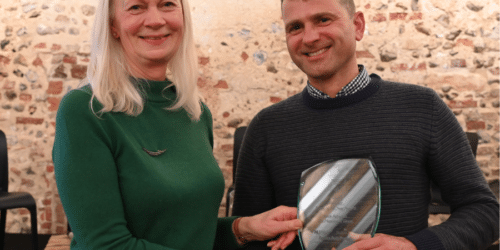
Sarah Perry introduced the East Anglian Book Awards on 4 November 2015 having won the Book of the Year Award in 2014 for After Me Comes the Flood, also long listed for the Guardian First Novel Award in the same year.
At the ceremony she shared her love of a region that has ‘never quite stopped thinking of itself as a Kingdom’. She praised the radical character of the East Anglia woman referencing Julian of Norwich, Elizabeth Fry, Harriet Martineau, Edith Cavell and of course Boudicca. With much to say on the East Anglian landcape she gives the final word to WG Sebald who with his translator Michael Hulse ‘captures more precisely than any other writer this kingdom’s unique qualities: melancholy, dreamlike, almost dangerous in its likelihood to induce existential unease.’
The East Anglian Book Awards not only hold a significant place in the literary calendar, but are very dear to me. Having been fortunate enough to have been awarded a prize last year, I know how the generosity and praise of peers can see a writer though a cold Tuesday afternoon when putting one word in front of another seems a hopeless endeavour.
I also know that those of you whose books have secured a place on the short list will be feeling more than a little on edge, and so I promise I will not speak long. But I’d like to spend a short while touching on the cultural history of East Anglia, and its strange, marvellous landscape, and try to understand how this region has produced such an embarrassment of literary riches.
Writing about Norfolk, and writing about writing about Norfolk, Malcolm Bradbury once said, “Sometimes our place is our real subject, the basic material we work with, providing our vision, setting, landscape and theme. Sometimes it is a culture which stimulates our writing and lets it happen.” Those who live and write here I think will recognise this twofold effect: sometimes the shingle and the fens, the curlews and skies are consciously our subject – at other times they lie several inches behind the printed page – but always they are there.
When I moved here after a wearisome decade in London, I remember quite clearly noting that the Norwich train bore an iron plate reading RAEDWALD. When at last I thought to look into it, it pleased me to see it referred to East Anglia’s king in the year 616, when this was the most powerful of all the Anglo-Saxon kingdoms. I like to think that East Anglia never quite stopped thinking of itself as a kingdom, and that this proud separateness is part of its allure. One does not arrive here by mistake, only by intent. Those of us who frequently make the journey home to Suffolk and Norfolk by train will know there is moment when, crossing (I think) the river Ouse – where white egrets stand impassively watching the trains – it is impossible to reach anyone by phone or email.
East Anglia never quite stopped thinking of itself as a kingdom, and that this proud separateness is part of its allure
On arrival, the stranger will find the dialects of Suffolk and Norfolk not only thrive, but are contagious: I have barely been here three years, but find myself adopting the Norwich habit of using ‘that’ for ‘it’: “Good morning! That’s a nice day, that is!” Here, a jackdaw is a cadder, a bittern is a buttle, and a heron is a harnser (which, incidentally, is perhaps what Hamlet meant when he pointed out that he knew a hawk from a handsaw). The use of language here is nimble and witty: if you drive for any distance through the countryside you’ll encounter groan-inducing puns on signs for cafes, farm shops and roadside hot dog stands (the only one that currently comes to mind is ‘Bear’s Grill’). Hilary Mantel, who lived for a time in Norfolk, recalls seeing an elderly neighbour stand on the doorstep, peer disconsolately upward, and remark that there’d not been enough rain to wet a stamp. Even the place-names seem playful, and almost certainly designed to outwit the outsider: there is no mortification quite so bad as mispronouncing Happisburgh or Wymondham. In fact, playfulness and invention seems integral to the East Anglian literary character, from Thomas Browne’s coinages – antediluvian, jocularity, electricity – to George Borrow, who entitled his memoir ‘Lavengro’, after a Romany phrase meaning ‘word-master’.
East Anglia has a long history of radicalism: political, social and religious. There was the rebel Kett, who led 16,000 men against the king and was hanged for his pains from Norwich Castle wall; the 16th century butchers, labourers, constables and painters burned at the stake for the sake of freedom of conscience in Walsingham and Thetford and on Ely Cathedral green; there was Thomas Clarkson of Wisbech, abolitionist and noted redhead. I don’t think it fanciful to say that this radical tradition thrives in the contemporary literature of East Anglia, which is willing to challenge, wary of convention, tends towards idiosyncrasy and is often disruptive.
It is impossible to account for the hold East Anglia has over writers and artists without considering its extraordinary landscape, much of which seems made of some element which is not quite water, and not quite land. It has a peculiarly eerie, melancholy quality: it does not dazzle, in the manner of the Scottish Highlands or the Cornish cliffs; rather, it clings to you, I think – like a scent, or like a sea-mist – often I find myself unable to distinguish between memories of walking on Holkham sand or the Aldeburgh shingle and all the strange dreams I have had. Robert MacFarlane’s description of a Suffolk sunset epitomises a kind of East Anglian nature writing which is beautiful, but which faintly disturbs: “At evening, as the sun was low and red in the sky, we crossed back over the River Ore, and into the woods and fields of Suffolk. A single mushroom-cloud of cumulonimbus dominated the eastern sky, and it was soaked in the red fission light of the sun.”
In H is for Hawk, Helen McDonald describes her beloved Brecklands, and again this is no chocolate-box landscape: “It’s where wet fen gives way to parched sand. It’s a land of twisted pine trees, burned-out cars, shotgun-peppered road signs and US Air Force bases. There are ghost here: houses crumble inside numbered blocks of pine forestry.”
Sometimes I wonder if I’ve seen more strange things in heaven and earth in the three years I have lived in East Anglia than in the thirty-two preceding. I have stood in the pine forest at Wells, where it is silent as a cathedral, and suddenly heard a volley loud as gunshot as all the pine cones overhead burst open in the heat of the sun. Later that same day, scanning the horizon over the sea, I saw a Fata Morgana, a disconcerting optical illusion in which fronts of cool air create refracting lenses that build strange, Brutalist black towers in the sky, which grew and diminished over the course of an afternoon.
Naturally enough, this uncanny land is ripe with myth – the most persistent kind of story: there’s Black Shuck, who scorched the door of Bungay church in 1577 and last made the headlines in 1971; there’s the Green Children of Woolpit, who would only eat beans, and the poor Orford Merman, who was tortured for refusing to speak and finally released back into the Ness.
The character of the East Anglian woman is radical, literate, rebellious, courageous, mystic and astute.
It seems curious to me that those responsible for the new British passport could rustle up a mere two women of significance between them. They ought to have looked East: here lived Julian of Norwich, whose Revelations of Divine Love was the first book by a woman to be published in English; here also lived Margery Kempe, who wrote the first autobiography to be published in English. Here lived the prison reformer Elizabeth Fry, here was born the great sociologist Harriet Martineau, here also lived the novelist and abolitionist Amelia Opie. Edith Cavell lived here, is buried here, and is remembered whenever beer is drunk in the pub named for her, and which is a stone’s throw from her memorial. Maggie Hambling was born here, Boudicca of the Iceni lived and died here. Britain’s first female surgeon Elizabeth Garrett Anderson was of Suffolk blood, Anne Boleyn was born in Blickling, and legend has it her heart is buried here. The character of the East Anglian woman is radical, literate, rebellious, courageous, mystic and astute.
I will finish by turning to the outsiders, since no-one should think that East Anglia – for all its remoteness and pride – does not welcome the stranger. In fact, one can barely cross the road without encountering a poet or novelist who has run here – often without quite intending to, yet never really meaning to leave. Eric Arthur Blair, born in India, named himself for the River Orwell; the great Irish writer Eimear McBride lives here, as does the Hungarian poet George Szirtes. Ian McEwan was born in Aldershot, but lived here long enough: it is impossible to read – for example – The Cement Garden without seeing something familiar in its eerie, remote setting.
Last night, while musing on Twitter about the lure of this land, the writer David Hayden replied that since being here the landscape has ‘insinuated’ itself into his writing: “Always the dark woods, the lone trees, the green river, the night heron.”
I will give the last words to Sebald – one of the greatest of East Anglian outsiders, who with his translator Michael Hulse captures more precisely than any other writer this kingdom’s unique qualities: melancholy, dreamlike, almost dangerous in its likelihood to induce existential unease. Giving an account of walking in Suffolk on a day sullen with heat, he said: “Several times I was forced to retrace long stretches in that bewildering terrain . . . In the end I was overcome by a feeling of panic. The low, leaden sky; the sickly violet hue of the heath clouding the eye; the silence, which rushed in the ears like the sound of the sea in a shell; the flies buzzing about me – all this became oppressive and unnerving….months after this experience, which I still cannot explain, I was on Dunwich Heath once more in a dream, walking the endlessly winding paths again, and again I could not find my way out of the maze which I was convinced had been created solely for me.”
Thank you.
East Anglian Book Awards

You may also like...
‘The Meaning of Geese’ wins East Anglian Book of the Year 2023
The debut book from Norfolk conservationist Nick Acheson is crowned the overall winner of the East Anglian Book Awards

16th February 2024
Announcing the category winners for the 2023 East Anglian Book Awards
Discover the six winning titles for the East Anglian Book Awards 2023

18th January 2024
Read three of the best poetry collections based in the East of England
Our weekly spotlight on an East Anglian Book Awards 2023 shortlist

19th December 2023






